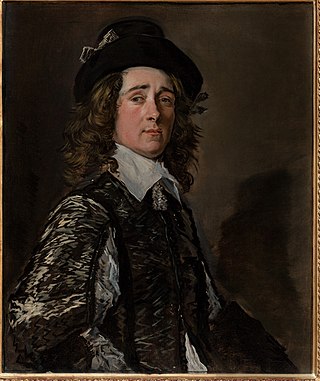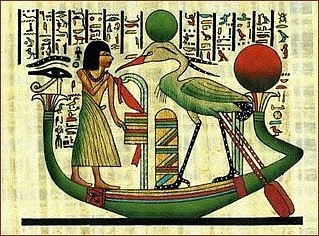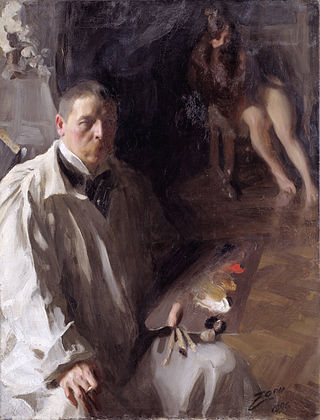
Acrylic paint is a fast-drying paint made of pigment suspended in acrylic polymer emulsion and plasticizers, silicone oils, defoamers, stabilizers, or metal soaps. Most acrylic paints are water-based, but become water-resistant when dry. Depending on how much the paint is diluted with water, or modified with acrylic gels, mediums, or pastes, the finished acrylic painting can resemble a watercolor, a gouache, or an oil painting, or it may have its own unique characteristics not attainable with other media.

Paint is a liquid pigment that, after applied to a solid material and allowed to dry, adds a film-like layer. As art, this is used to create an image, known as a painting. Paint can be made in many colors and types. Most paints are either oil-based or water-based, and each has distinct characteristics.

Printmaking is the process of creating artworks by printing, normally on paper, but also on fabric, wood, metal, and other surfaces. "Traditional printmaking" normally covers only the process of creating prints using a hand processed technique, rather than a photographic reproduction of a visual artwork which would be printed using an electronic machine ; however, there is some cross-over between traditional and digital printmaking, including risograph.

A crayon is a stick of pigmented wax used for writing or drawing. Wax crayons differ from pastels, in which the pigment is mixed with a dry binder such as gum arabic, and from oil pastels, where the binder is a mixture of wax and oil.

Gouache, body color, or opaque watercolor is a water-medium paint consisting of natural pigment, water, a binding agent, and sometimes additional inert material. Gouache is designed to be opaque. Gouache has a long history, having been used for at least twelve centuries. It is used most consistently by commercial artists for posters, illustrations, comics, and other design work.

Watercolor or watercolour, also aquarelle, is a painting method in which the paints are made of pigments suspended in a water-based solution. Watercolor refers to both the medium and the resulting artwork. Aquarelles painted with water-soluble colored ink instead of modern water colors are called aquarellum atramento by experts. However, this term has now tended to pass out of use.

Oil paint is a type of slow-drying paint that consists of particles of pigment suspended in a drying oil, commonly linseed oil. The viscosity of the paint may be modified by the addition of a solvent such as turpentine or white spirit, and varnish may be added to increase the glossiness of the dried oil paint film. The addition of oil or alkyd medium can also be used to modify the viscosity and drying time of oil paint. Oil paints were first used in Asia as early as the 7th century AD and can be seen in examples of Buddhist paintings in Afghanistan. Oil-based paints made their way to Europe by the 12th century and were used for simple decoration, but oil painting did not begin to be adopted as an artistic medium there until the early 15th century. Common modern applications of oil paint are in finishing and protection of wood in buildings and exposed metal structures such as ships and bridges. Its hard-wearing properties and luminous colors make it desirable for both interior and exterior use on wood and metal. Due to its slow-drying properties, it has recently been used in paint-on-glass animation. The thickness of the coat has considerable bearing on the time required for drying: thin coats of oil paint dry relatively quickly.
Water-miscible oil paint is oil paint either engineered or to which an emulsifier has been added, allowing it to be thinned and cleaned up with water. These paints make it possible to avoid using, or at least reduce volatile organic compounds such as turpentine that may be harmful if inhaled. Water-miscible oil paint can be mixed and applied using the same techniques as traditional oil-based paint, but while still wet it can be removed from brushes, palettes, and rags with ordinary soap and water. One of the ways its water solubility comes from is the use of an oil medium in which one end of the molecule has been engineered to be hydrophilic and thus bind loosely to water molecules, as in a solution. This type of paint is different to those that are engineered to enable cleaning of brushes and application equipment in water but are not in themselves water reducible.

Wet-on-wet, or alla prima, direct painting or au premier coup, is a painting technique in which layers of wet paint are applied to previously administered layers of wet paint. Used mostly in oil painting, the technique requires a fast way of working, because the work has to be finished before the first layers have dried.

Aerosol paint is paint that comes in a sealed, pressurized container and is released in an aerosol spray when a valve button is depressed. The propellant is what the container of pressurized gas is called. When the pressure holding the gas is released through the valve, the aerosol paint releases as a fine spray. Aerosol painting is one form of spray painting; it leaves a smooth, even coat, unlike many traditional rolled and brushed paints. Aerosol primer can be applied directly to bare metal and many plastics.
Sennelier is a French manufacturing company of art materials, mostly famous for its hand selected pigments. The company produces a wide range of paint products, including acrylic, oil, watercolor, gouache, oil and soft pastel, india ink, tempera, and other media.
Aureolin is a pigment sparingly used in oil and watercolor painting. Its color index name is PY40. It was first made in 1831 by Nikolaus Wolfgang Fischer in Breslau characterizing it as "Doppelsalze" or double-salts and its chemical composition is potassium cobaltinitrite. He characterized it again and wrote more extensively about it in 1842, naming it "Salpetrichtsaures Kobaltoxydkali". In 1851–1852, Edouard Saint-Evre synthesized cobalt yellow independently. He is credited with the introduction of cobalt yellow as an artists pigment. The investigation by Gates gives the exact modern procedures for the preparation of aureolin and also the methods for its identification in paintings.

A wash is a term for a visual arts technique resulting in a semi-transparent layer of colour. A wash of diluted ink or watercolor paint applied in combination with drawing is called pen and wash, wash drawing, or ink and wash. Normally only one or two colours of wash are used; if more colours are used the result is likely to be classified as a full watercolor painting.

Painting is a visual art, which is characterized by the practice of applying paint, pigment, color or other medium to a solid surface. The medium is commonly applied to the base with a brush, but other implements, such as knives, sponges, and airbrushes, can be used.

Utrecht Art Supplies is an art materials manufacturing and chain store company, based in Brooklyn. Utrecht, founded in 1949 in New York City by artist Norman Gulamerian and his brother Harold Gulamerian, sells a large range of art material brands including its own line of products. Art materials produced by Utrecht include acrylics, watercolor, oils, brushes In 2013, Utrecht was acquired by Dick Blick, one of the chain's largest competitors. As a result, Dick Blick became "Blick Art Materials". Products sold at Utrecht stores include acrylic, oil, watercolor, brushes, canvas, papers, pencils, inks. Utrecht art supply also sells office supplies such as adhesives, paper clips, push pins, and others.

Royal Talens is a Dutch company located in Apeldoorn that specializes in art materials. The company produces and markets its own products, apart from commercializing other licensed brands, such as Van Gogh, Rembrandt, and Bruynzeel. Products commercialised include acrylic paints, oil paints, watercolor paintings, brushes, markers, inks, pastels, pencils, pens, gouache, canvas, papers.

Watercolor paper is paper or substrate onto which an artist applies watercolor paints, pigments, or dyes. Many types of watercolour papers that are manufactured for the use of watercolors are currently available. Watercolor paper can be made of wood pulp exclusively, or mixed with cotton fibers. Pure cotton watercolor paper is also used by artists, though it typically costs more than pulp-based paper. It is also available as an acid-free medium to help its preservation.

The conservation and restoration of paintings is carried out by professional painting conservators. Paintings cover a wide range of various mediums, materials, and their supports. Painting types include fine art to decorative and functional objects spanning from acrylics, frescoes, and oil paint on various surfaces, egg tempera on panels and canvas, lacquer painting, water color and more. Knowing the materials of any given painting and its support allows for the proper restoration and conservation practices. All components of a painting will react to its environment differently, and impact the artwork as a whole. These material components along with collections care will determine the longevity of a painting. The first steps to conservation and restoration is preventive conservation followed by active restoration with the artist's intent in mind.

Paint mixing is the practice of mixing components or colors of paint to combine them into a working material and achieve a desired hue. The components that go into paint mixing depend on the function of the product sought to be produced. For example, a painter of portraits or scenery on a canvas may be seeking delicate hues and subtle gradiations, while the painter of a house may be more concerned with durability and consistency of colors in paints presented to customers, and the painter of a bridge or a ship may have the weatherability of the paint as their primary concern.

Frederick William Weber was a chemist, artist, columnist and businessman from Philadelphia, Pennsylvania. An expert on the chemistry and physics of paint materials, Weber served as treasurer, technical director and eventually president of F. Weber & Company, Inc., an artists’ supplies manufacturer founded in 1853. Weber developed new techniques for the manufacture of inks and pigments, and played a major role in the introduction of synthetic resins to the paint-making process.


















